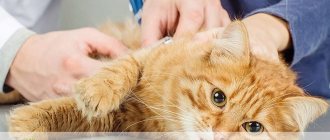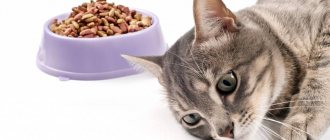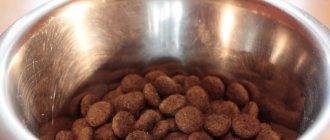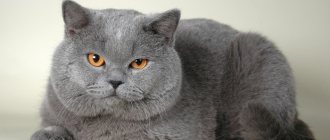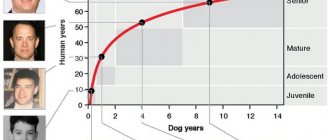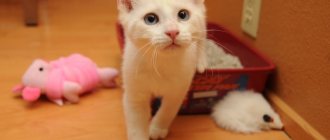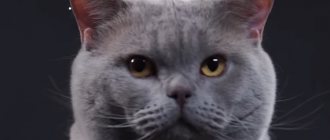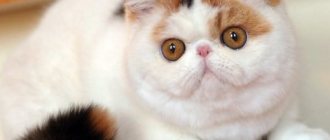Cats are one of the world's favorite pets, but as more of them spend their lives indoors, they're also putting on weight. Obesity can lead to a number of health problems, but most importantly, it shortens their life. If you want to keep your pet healthy but don't know how to tell if he's overweight, we're here to help.
The average domestic cat should weigh (3.6-4.4 kg.
But there are several factors that can change these values, so keep reading as we discuss how to determine the ideal weight for your cat and how to make adjustments so your cat can live a long, healthy life.
We've divided your cat's weight into five categories to help you determine if your cat is overweight and answer the age-old question: "How much should a cat weigh?"
Cat weight categories
Very low weight
Very low weight cats require immediate attention. It is rare to see a cat in this condition unless it is a stray or someone is neglecting it. Very low weight cats will have visible ribs that can be seen from the sides and top. The bones around the tail will not be covered in fat and will be more prominent than normal. The tummy tuck will be extreme and they will usually have little energy for grooming, hunting or playing. If it is a stray, it will lose its fear of people and will approach you in search of food.
Decrease in norm
If, when weighing the animal, you find that the kitten’s weight is below normal, while it has a completely healthy appearance and active behavior, then in this case you just need to observe the kitten.
In some cases, kittens between seven and nine months of age do not gain weight well, or even lose it altogether. This may be due to puberty of individuals and changes in the animal’s hormonal levels.
It’s another matter if, when examining the animal, you find protruding ribs, uneven coat, and protruding pelvic bones. All these signs may indicate serious illnesses for which a visit to the veterinarian should not be postponed.
Source
Underweight
Underweight cats will have a little more fat than previous types of cats, but not by much. You'll still see the rib bones from the side and they'll be easy to feel when you pet the cat, but they may be harder to see from above.
The bones around the tail will have a soft padding, but they will still be visible and clearly visible, and there will be an excessive tummy tuck. Even though they are underweight and need food immediately, they will still have plenty of energy to hunt and play, and may even want to hide or run away from people when confronted. Most stray cats are underweight, especially if they have a large population or it's winter.
Why does a kitten weigh less than normal and what to do about it?
There is no need to panic if the baby’s weight is slightly below normal, but he is cheerful, active and does not have any alarming symptoms such as vomiting, diarrhea, excessive salivation, dull hair, etc.
If there is significant underweight, when the kitten's ribs and pelvic bones are visible, you should immediately contact a veterinarian. Frequent reasons for such deviation:
- Starvation. A hungry kitten looks exhausted, lethargic, has bloating and diarrhea, and in severe cases, symptoms of rickets and anemia. Underweight may be due to a lack of mother's milk or an unbalanced diet when the kitten has already been weaned. It is necessary to increase the volume of mother's portions by 2–3 times during lactation. If this measure does not give the desired result, you need to supplement the baby with formula milk.
- Taste of milk. Sometimes a kitten refuses mother's milk because of its bitter taste, which appears due to the cat's postpartum illness (for example, mastitis or acute metritis). The baby looks exhausted, meows pitifully, and has bloating, diarrhea and redness of the anus. In order not to provoke blood poisoning, the baby is transferred to artificial feeding and detoxification therapy is carried out.
- Parasitic disease. A sick pet, despite a good appetite, does not gain weight. The baby has a tight belly, dull fur, sometimes constipation or diarrhea, traces of blood, mucus and parasite eggs are visible in the stool. The developmental delay is due to exhaustion: the incoming nutrients are spent not on the growth of the kitten, but on maintaining the vital activity of helminths. Worm infestation is especially dangerous at this age and can be fatal, so you should immediately contact a veterinarian.
- Diseases of the gastrointestinal tract. In this case, the kitten even loses body weight, because due to the disease, the mucous membrane of the digestive tract is affected, and nutrients are no longer absorbed by the body. A sick baby experiences symptoms such as vomiting, fever, excessive salivation, changes in stool, etc. A complete cure requires complex therapy, including not only treatment of the underlying disease, but also vitamin therapy and special nutrition.
Stress
Early separation from the mother, moving, increased attention from family members, loud noises, etc.
– all this causes discomfort to the baby, forcing him to refuse food and seek shelter
During this period, it is important not to impose games on your pet and give him the opportunity to adapt to new conditions.
Obesity
© shutterstock
Like very low weight cats, obese cats require immediate attention. These cats have several health problems, including heart disease, diabetes, kidney disease and more, which shorten their lives. The extra weight will also take a toll on the joints, making it difficult for your cat to climb and jump as usual. The added fat can also make it difficult for your lungs to expand and breathe normally. You may also notice your cat snoring more often. In a fat cat, it will be difficult to feel the ribs and you will see clear fat deposits in the lower back, face and limbs. There will be no visible waist, a very noticeable round belly area with thick fat padding, and the backside will bulge out when viewed from above.
Rules for weighing kittens
In the first weeks of life, kittens are weighed every day. Weighing them daily helps monitor whether they are developing and feeding normally. To obtain the most correct values, weighing occurs at the same time.
Babies are weighed on kitchen scales
Daily fluctuations in the kitten's weight are very small - only 10-15 grams. Regular floor scales will not show such a small difference in weight, so it is better to weigh kittens on a kitchen scale. Keep the mother cat close to the kittens during the weigh-in, otherwise she will become agitated. Excessive stress can negatively affect the quality of milk, so let the kitty calmly watch her offspring.
Cat weight chart
| Physical Traits | |
| Very low weight | ● Dull fur. ● Visible ribs. ● Not soft hoof bones. ● low energy ● Dangerous to life. ● Extreme tummy tuck. |
| Underweight | ● The ribs are visible from the side. ● Padding may obscure ribs when viewed from above. ● Small padding on the tailbones. ● Extreme tummy tuck. |
| Perfect | ● Barely noticeable ribs. ● Soft, underwired ponytail creates a defined hip line. ● Shiny coat. ● Energetic ● Minor tummy tuck. |
| Overweight | ● No visible ribs. ● After the chest, the waist is not visible. ● Round belly with fat pad. ● Slight bulge at the rear when viewed from above. |
| Obesity | ● No visible ribs. ● Visible fat deposits. ● Very clearly rounded belly, thick pad of fat. ● Less energy ● difficulty breathing. ● Dangerous to life. |
Table
Sequence of administration
When first examining a dog or cat, the veterinarian will pay special attention to the head and neck. The skull should be symmetrical, and the mucous membranes of the eyes should be pink and shiny
The position of the eye in the orbit and the reaction of the pupil to light are assessed. Then the ears are examined. The ear should normally be sensitive to sound. The auditory canal is examined from the outside and inside. Our clinic uses a slit lamp to visually detect eye pathology in an animal. An otoscope is used to examine the ear canal.
When examining the oral cavity, the condition of the mucous membranes, gums, teeth, bite, and the presence or absence of tartar is assessed.
The submandibular lymph nodes are palpated and neck mobility is assessed.
When examining the chest, the integrity of the ribs is checked, the lungs and heart are auscultated, this allows us to identify pathologies of the cardiovascular system and lung diseases. If a patient comes to an appointment with such problems, our clinic has the opportunity to quickly conduct additional instrumental studies (ultrasound of the heart with color Doppler, X-ray).
Palpation of the abdominal cavity is carried out to detect large tumors and identify pain in the internal organs.
In males, the scrotum is examined with mandatory palpation of the testes and penis, and the presence or absence of cryptorchidism is determined. In females, the vulva and mammary glands are examined.
Examination of the condition of the skin - be sure to check the animal for the presence of ectoparasites (fleas, lice eaters), evaluate skin turgor, the presence or absence of pathological molting.
Be sure to examine the front and hind limbs and tail.
At each appointment, thermometry is required: in dogs, the normal body temperature is 37.6 - 39.1 degrees, in cats 38 - 39 degrees.
Ideal cat weight
Many experts recommend that your cat weigh between 4.5 and 5.5 kg, but this is not always the case. The International Cat Association recognizes over 70 cat breeds, and each breed will have different characteristics, including their ideal weight.
Image Credit: Andrew Chan, Flickr
For example, the Singapura cat is one of the smallest cats and you want it to weigh between 2 and 3.5 kg. The Maine Coon is the largest breed, and females will weigh between 5.5 and 7 kg, while males can be even heavier, up to 10 kg.
However, the Domestic Shorthair is one of the most common domestic cats, and unless you have purchased a specific breed, it is probably a Domestic Shorthair. These cats typically weigh around 10 pounds, but this can still vary and you will need to determine the ideal weight for your cat on a case-by-case basis.
How much does a cat weigh and developmental features?
1 month
An average monthly cat weighs 400-500 grams. He actively begins to explore the world, crawls out of the box on his own, and gets acquainted with adult food. At this age they love to play and sleep often, but little.
At 1.5, babies' eye color changes. They begin to look for the tray on their own and visit it regularly. This is a good age to look for new owners.
2 months
Pet weight 450-900 g.
At this age, kittens have heightened curiosity - they explore the world around them, try everything with their teeth and paws.
Playful, affectionate. Their outlines take on those of an adult cat.
Two-month-old kittens are already accustomed to combing, washing and trimming their nails.
3 months
The weight of the cat is 1000-1500 g.
He is already playful and affectionate, accustomed to his owner and affection. Responds to a nickname, independently finds a tray, bowls of food and water.
Three-month-old kittens have fully formed eye color, as well as baby teeth.
By this age, boys surpass their sisters in size.
4 months
Hang 1700-2400 gr.
Kittens become less playful, although they like to chase toys around the house. They become like adult cats: they sleep more, go to the bowl less often, and become calm and affectionate.
The replacement of baby teeth with permanent ones begins.
They hang 2200-2900 gr.
Kittens are slightly smaller than an adult cat. At this age they are transferred to three meals a day.
Half a year
Hang 2300-3600 gr.
Six-month-old cats have finished changing their teeth.
They are proportionally harmonious and graceful in their movements. Hunting instincts are developed.
At 6 months, kittens end their active growth phase and gain significantly less weight.
7 months
Hangs 2400-3900 g.
Males and cats begin their first molt and puberty. If a girl and a boy live together, then they begin to be interested in each other, and the males court the females.
Now the pet needs regular brushing so that the fur it licks off does not cause stomach upset.
8 months
Hangs 2500-4100 g.
At this age, it is recommended to spay and neuter cats if they are not planned for breeding.
2500-4300 gr.
At this age, kittens look like adult cats and gain almost no weight.
10 months
Hangs 2500-4400 g.
At this age, cats begin their first heat.
It is not recommended to breed cats before 12 months of age to avoid birth complications.
From the age of ten months, kittens participate in exhibitions in adult categories.
11 months
Hangs 2500-4500 g.
A fully formed adult animal that has stopped growing. Now you can switch your pet to adult food.
Year
Hangs 2500-4600 g.
Already an adult animal that eats food for adult animals is able to participate in mating and exhibitions.
Some breeds are fully mature by age two, such as Maine Coons.
How to Tell If Your Cat Is a Healthy Weight
The best way to determine if your cat is the right weight is to use our picture guide above and do a visual test. There should be no fat deposits on the cat, but there should be no ribs, especially when looking at the cat from above. He should have a shiny coat that requires frequent grooming, he should have a lot of energy, and he should love to play. His breathing should not seem labored and he should be able to jump fairly easily on high stances.
Cats that are too heavy may have difficulty grooming themselves and may develop mats, especially if they have long hair. He will stop trying to jump on high counters and won't run around as much. His breathing may seem labored, as if his nose is stuffy, and he is more likely to snore. Fat deposits will be visible and especially noticeable when the cat is running.
Symptoms of gastric pathology
The following manifestations may indicate problems in this area:
- pain in the stomach, feeling of fullness, heaviness after eating;
- pain behind the sternum, in the epigastric region;
- difficulty swallowing food;
- feeling of a foreign body in the esophagus;
- belching with a sour taste;
- heartburn;
- nausea, vomiting of undigested food;
- vomiting with blood;
- increased gas formation;
- black stool, bleeding during bowel movements;
- bouts of ravenous hunger/lack of appetite.
Of course, previously identified pathologies of the digestive system are serious indications for gastroenterological examination:
- gastritis;
- reflux disease;
- pancreatitis;
- cholecystitis;
- peptic ulcer;
- cholelithiasis;
- polyps and other formations;
- inflammatory processes;
- oncological diseases, etc.
What to do if your cat is overweight
Unfortunately, helping your cat lose weight is not easy, and it is far preferable to prevent your cat from becoming fat in the first place. Cats can quickly develop fatty liver disease if you try to force them to lose weight too quickly. Fatty liver disease affects your cat's ability to process blood and can be life-threatening.
However, you can follow a few simple steps to help your cat lose weight gradually.
- Feed your cats a quality food with plenty of animal protein and avoid grains. Avoid foods containing corn and soy.
- Feed your cat 3-4 small meals throughout the day instead of giving her food whenever she wants it.
- Spend a few minutes every day playing with your cat to get her more active. Laser pens are a great way to get your cat to run around.
- Take your cat to the vet for a recommendation.
Posted by Christian Adams An American expat living in Metro Manila, Philippines for over a decade, Christian is a lifelong cat lover and the proud father of two rescue cats, Trixie and Chloe. Both girls used to be among the crowds of homeless people who roam the cities and countryside. Three-year-old Trixie was rescued from a litter found under a neighbor's porch, and two-year-old Chloe was brought home by Christian's young son, Henry, who discovered the crying kitten in the parking lot.
Diagnosis of stomach diseases
Diagnosis of stomach diseases is a whole complex of studies, including physical, instrumental, and laboratory methods.
Diagnosis begins with a survey and examination of the patient by a gastroenterologist. Next, based on the collected data, the doctor prescribes the necessary studies.
Instrumental diagnosis of stomach diseases involves the use of such informative methods as:
- gastroscopy (or esophagogastroduodenoscopy, endoscopy);
- Ultrasound of the abdominal organs;
- CT scan;
- fluoroscopy;
- magnetic resonance imaging.
The complex of laboratory methods for diagnosing stomach diseases usually includes:
- general blood analysis;
- blood chemistry;
- general analysis of urine, feces;
- gastropanel;
- pH-metry;
- analysis for tumor markers;
- breath test for Helicobacter pylori.
General blood analysis. This study is indispensable for assessing the state of health in general. When diagnosing gastrointestinal diseases by changes in indicators (ESR, erythrocytes, leukocytes, lymphocytes, hemoglobin, eosinophils, etc.), one can ascertain the presence of inflammatory processes, various infections, bleeding, and neoplasms.
Blood chemistry. The study helps to identify dysfunctions of the gastrointestinal tract, to suspect an acute infection, bleeding or growth of a tumor in the subject.
General urine analysis. Based on characteristics such as color, transparency, specific gravity, acidity, etc., as well as the presence of inclusions (glucose, blood or mucous inclusions, protein, etc.), one can judge the development of an inflammatory or infectious process or neoplasms.
General stool analysis. The study is indispensable in diagnosing bleeding and digestive dysfunction.
Tumor markers. To identify malignant tumors of the gastrointestinal tract, specific markers are used (REA, CA-19-9, CA-242, CA-72-4, M2-RK).
PH-metry. This method allows you to obtain data on the level of acidity in the stomach using flexible probes equipped with special measuring electrodes, which are inserted into the stomach cavity through the nose or mouth.
It is carried out in cases where the doctor needs this indicator to make a diagnosis, to monitor the patient’s condition after gastrectomy, as well as to assess the effectiveness of drugs designed to reduce or increase the acidity of gastric juice.
RN-metry is carried out in a medical facility, under the constant supervision of a doctor.
Gastropanel. A special set of blood tests that helps assess the functional and anatomical state of the gastric mucosa.
The gastroenterological panel includes the most important indicators for diagnosing gastric pathologies:
- antibodies to Helicobacter pylori (these antibodies are detected in patients suffering from gastritis, duodenitis, peptic ulcer);
- gastrin 17 (a hormone that affects the regenerative function of the stomach);
- pepsinogens I and II (the level of these proteins indicates the condition of the mucous membrane of the body of the stomach and the organ as a whole).

